
How climate change is tweaking the taste of wine
Soon after the devastating Glass Fire sparked in California's Napa Valley in September 2020, wine chemist Anita Oberholster's inbox was brimming with hundreds of emails from panicked viticulturists. They wanted to know if they could harvest their grapes without a dreaded effect on their wine: the odious ashtray flavour known as smoke taint.
Oberholster, of the University of California, Davis, could only tell them: "Maybe."
Industry laboratories were slammed with grape samples to test, with wait times of up to six weeks. Growers didn't know whether it was worth harvesting their crops. Eight percent of California wine grapes in 2020 were left to rot.
Winemakers are no strangers to the vicissitudes wrought by climate change. Warmer temperatures have been a boon to some in cooler regions who are rejoicing over riper berries – but devastating to others. Scorching heat waves, wildfires and other climate-driven calamities have ruined harvests in Europe, North America, Australia and elsewhere.
And as 2020 showed, climate change can take its toll on grapes without directly destroying them. Wildfires and warmer temperatures can transform the flavour of wine, whose quality and very identity depends on the delicate chemistry of grapes and the conditions they're grown in. Many growers and winemakers are increasingly concerned that climate change is robbing wines of their defining flavours, even spoiling vintages entirely.
"That's the big worry," says Karen MacNeil, a wine expert living in Napa Valley and author of The Wine Bible. "That's the heartbeat of wine – it's connected to its place."
The greatest challenge that climate change brings to winemaking is unpredictability, MacNeil says. Producers used to know which varieties to grow, how to grow them, when to harvest the berries and how to ferment them to produce a consistent, quality wine – but today, every step is up in the air. This growing recognition is spurring researchers and winemakers to find ways to preserve beloved grape varieties and their unique qualities under the shifting and capricious conditions of today's warming world.
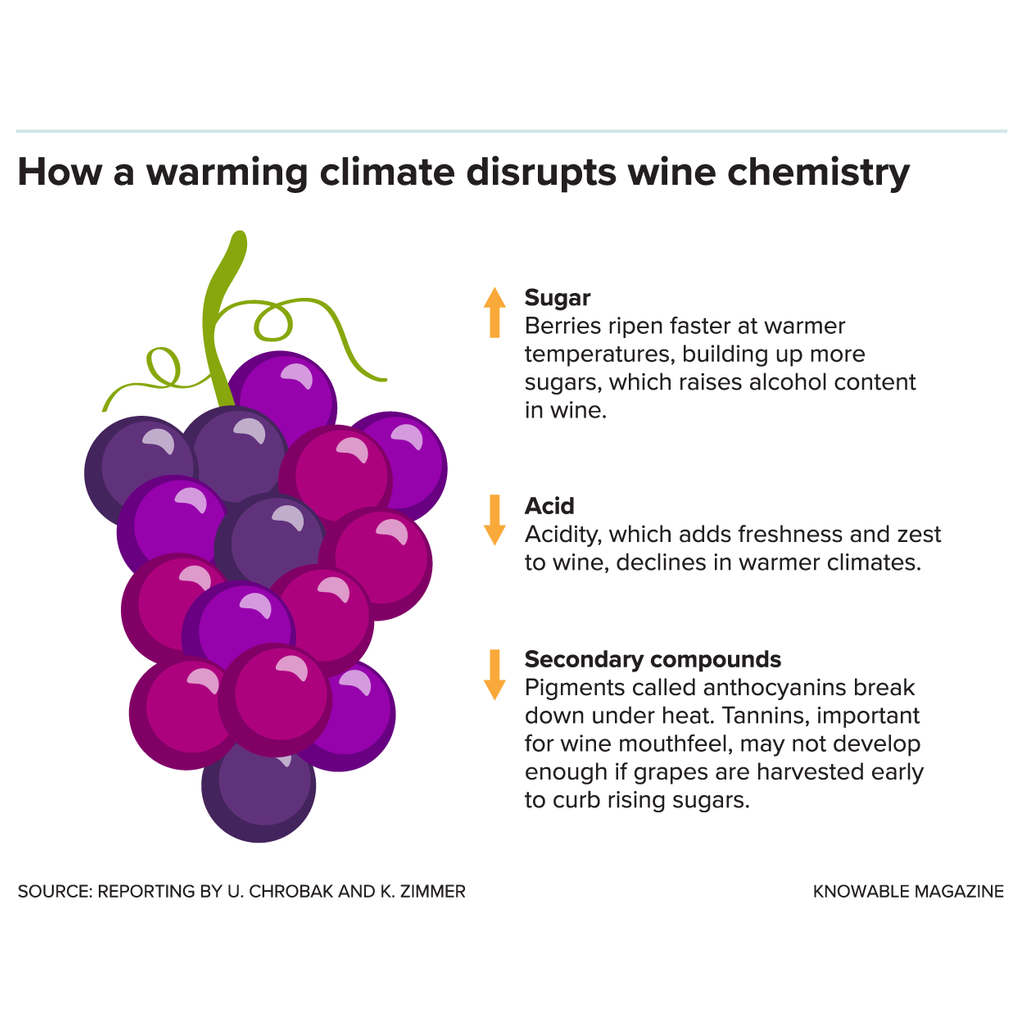 In a warmer climate, wines frequently become more alcoholic, less acidic and have fewer secondary compounds
In a warmer climate, wines frequently become more alcoholic, less acidic and have fewer secondary compounds
To learn about the threats to our favourite beverage, we spoke with experts from two renowned wine regions – Bordeaux in France and California in the US – to understand how climate change is uprooting their traditional vines and wines, and travelled to the University of California, Davis (UC Davis) and nearby Napa Valley in late 2021 to speak with scientists, growers and winemakers.
We were treated to an inside look at how every stage of winemaking is transforming to preserve desired flavours and aromas – and yes, got to taste a lot of wine, from the finest Cabernet Sauvignon to samples spoiled by smoke and scorching heat.
From testing new grape varieties to adapting fermentation, growers and winemakers are finding ways to mitigate climate impacts.
The taste of climate change
Weather extremes can kill even the hardiest vines, but much of the climate threat is an invisible one: chemical changes in the berries.
That's because wine quality, at its most granular, boils down to achieving balance between three broad aspects of berries: sugar, acid and secondary compounds. Sugar builds up in berries as vines photosynthesise, and acid breaks down as the grapes ripen. Secondary compounds – basically, chemicals beyond those essential to the plant's core metabolism – accumulate over the season. Ones called anthocyanins give red grapes their colour and protect the plant against UV rays. Others called tannins give wines bitterness and an astringent, drying mouthfeel; to the vines, they offer defence against grazing animals and other pests.
These three components, and therefore wine flavour, are affected by numerous environmental factors, including soil types, rainfall levels and fog, all of which are encompassed in the French word "terroir". Climate – long-term patterns of temperature and precipitation – is the biggest part of terroir, Oberholster says.
When a region's climate changes, that can disrupt the balance of sugar, acid and secondary compounds by changing the rate at which they develop over the growing season, says Megan Bartlett, a plant biologist studying viticulture at UC Davis. Grapes, like most fruit, break down acids and accumulate sugar as they ripen. At warmer temperatures, ripening is supercharged, leading to sweet, raisin-like flavour in grapes.
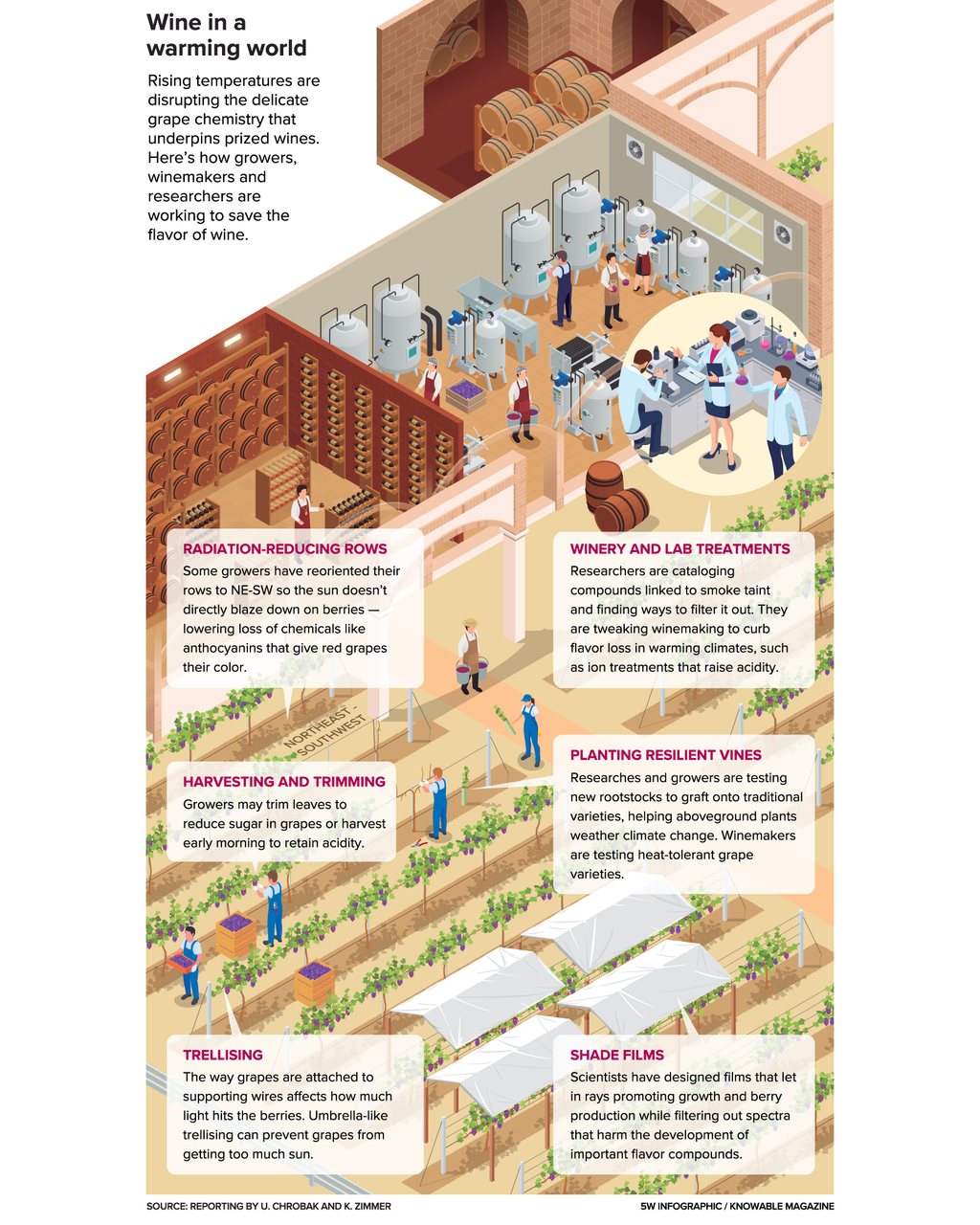 Wine growers are experimenting with an array of solutions to the challenge of producing wine in a warming world
Wine growers are experimenting with an array of solutions to the challenge of producing wine in a warming world
Yeasts consume those sugars during fermentation and excrete alcohol, so fermenting sweeter berries leads to higher wine alcohol content – and, indeed, wines in warm regions such as southern France are growing boozier. That's an undesirable trend for the region's consumers, especially since it's accompanied by a drop in acidity, says Cécile Ha, a spokesperson for the Bordeaux Wine Council. Acidity affords a fresh fruitiness and ensures that wines last for years in the cellar.
In some wines, higher alcohol creates a burning taste and masks subtle aromas, says Carolyn Ross, a food scientist at Washington State University who catalogued wine aroma compounds in the Annual Review of Food Science and Technology. Boozier wines also tend to taste spicier. And so, as the weather gets hotter, "you're getting pushed more and more towards that Zinfandel style," Bartlett says. "Which is great if Zinfandel is what you're going for. But if you've planted Pinot or you've planted Cab, you're no longer really expressing the best version of that variety."
If the story were simply about sugar and acid, the solution would be relatively simple: harvest grapes earlier, before they turn too sweet and while they still retain their tartness. But growers also want that stew of secondary compounds to build up, because these create the layered aromas key to quality wines. This can force wine producers to choose between harvesting early without fully developed tannins and anthocyanins or harvesting later when berries are loaded with those compounds but are overly sweet as well.
All things being equal, the changes in grapes due to warmer growing temperatures bring out more ripe, or "cooked", flavours in wine. MacNeil puts the progression this way: "an unripe cherry, to an almost-ripe cherry, to a ripe cherry, to cherry juice, to cherries that have been cooked down on the top of a stove like if you're going to make a pie, to dried cherries that are almost like raisins." For wines from warmer spots, climate change is worrisome because they're at risk of losing their sense of place as more and more wines become raisiny. ("All raisins taste the same," says MacNeil.)
A blurring between wines is already affecting the industry, fuelled by warmer temperatures and greater weather unpredictability as well as increased exchanges of growing techniques. It's made the certification of master sommeliers – a vexingly difficult exam that includes guessing a wine's variety, year and region – even harder.
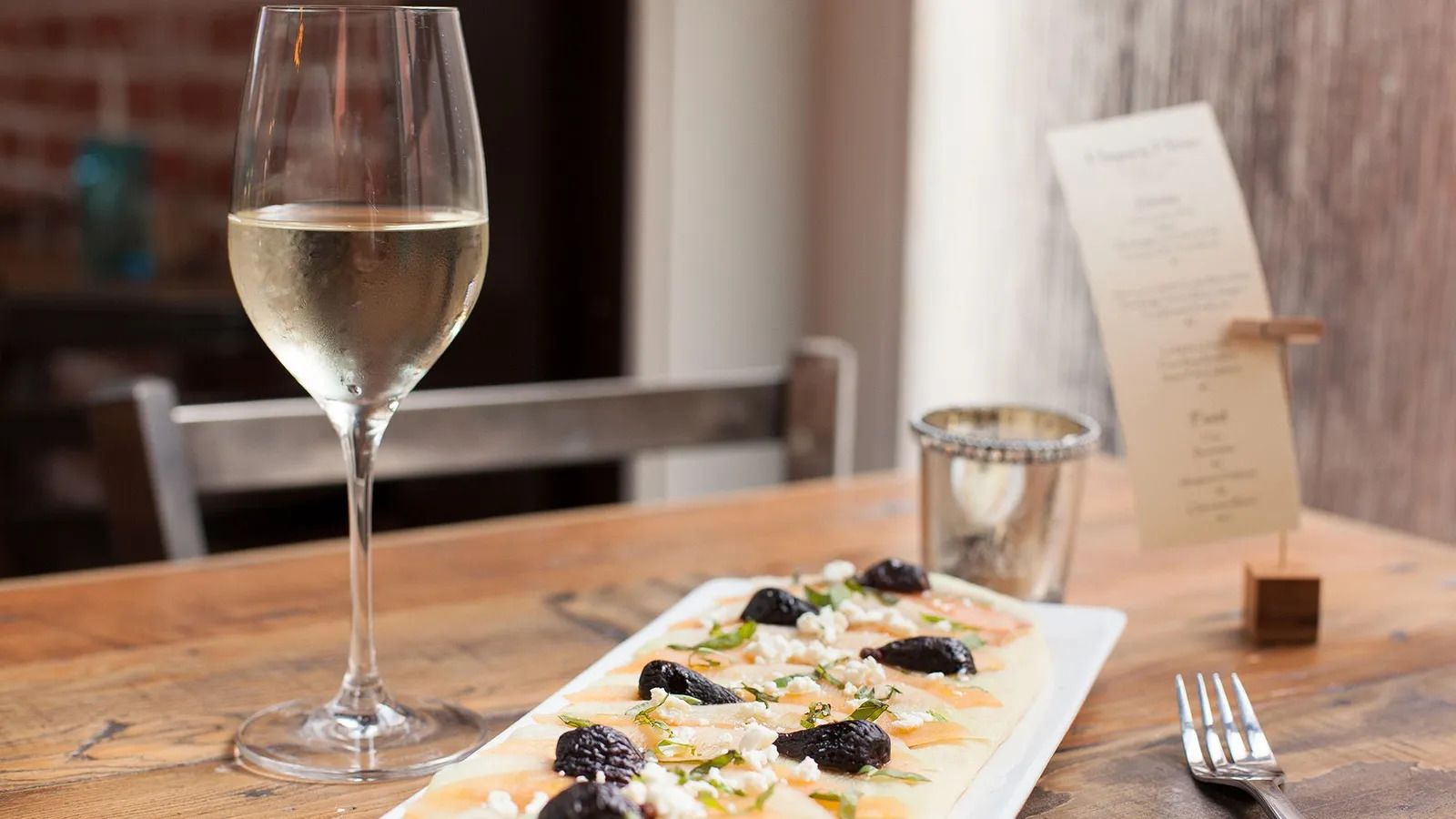 The climate in which a wine grows has far-reaching effects on its aroma and flavour
The climate in which a wine grows has far-reaching effects on its aroma and flavour
"There are a lot of people who are older masters of wine and master sommeliers who will tell you that if they had to take that exam now, especially the tasting exam, they would never pass it," MacNeil says.
The flavour of fire
These shifts in wine flavour are subtle in comparison to that other, dreaded climate impact: smoke taint. While a little smokiness imparted from, say, barrel-aging, might enhance a wine, this is a "very characteristic ashtray character at the back of your throat," as Oberholster describes it, with notes such as "Band-Aid" and "medicinal".
Compounds called volatile phenols, produced when wood is burned, seep into grapes and accumulate mainly in the skins. The phenols are bound up with sugars into odourless compounds called glycosides – until fermentation, when some of these phenols break free, imparting the distinct, overpowering flavour. (The breakdown continues in bottle or barrel and mouth.) The taste is most pronounced when the berries are bathed in fresh smoke rather than older smoke.
The experience is "retro-nasal," meaning the aroma rises into your sinuses once the wine is on your tongue; it's estimated that 20-25% of people can't taste it, potentially because their saliva lacks enzymes that break bonds to release the smoky notes. It's primarily a threat to red wines, because reds are fermented with the grape skins.
The recent surge of intense wildfires, worsened by climate change, has made Napa growers anxious each year as the autumn grape harvest approaches. Since 2017, heavy smoke has hovered over Napa vineyards most years. Worried grape growers have reached out to Oberholster for guidance, and the chemist has fermented numerous test batches exposed to varying levels of smoke.
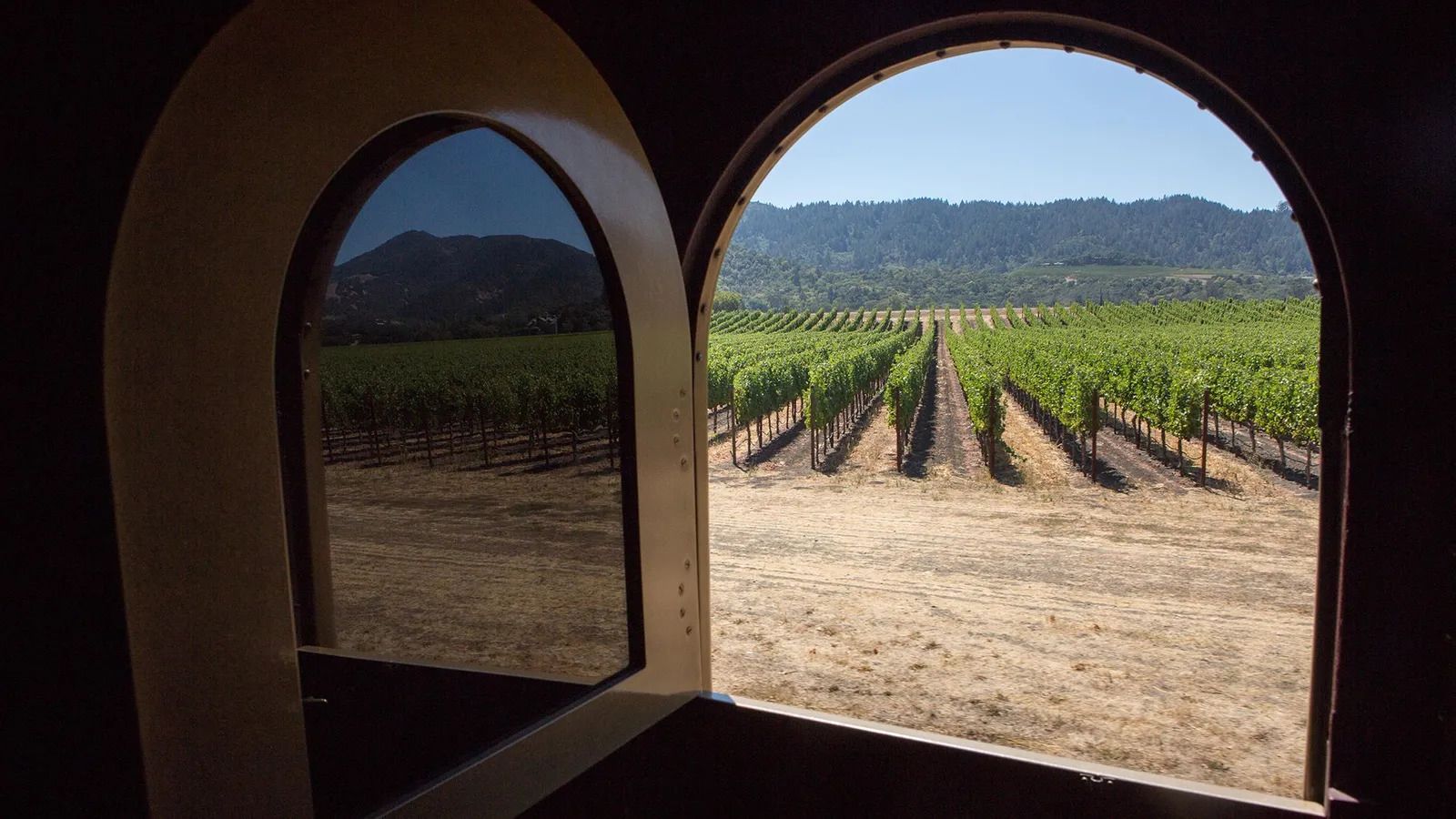 Many Napa Valley vines have been tainted by the smoke from wildfires in recent years
Many Napa Valley vines have been tainted by the smoke from wildfires in recent years
On the day that we meet with her, Oberholster takes us to a 24,000-bottle-capacity library of wine at the UC Davis Robert Mondavi Institute. She tracks down two reds from the stacks, handing us the 2020 vintages. One is a moderately tainted wine from grapes exposed to a week of smoke from the Glass Fire; the other is a heavily tainted fermentation from grapes that endured smoke from a large complex of lightning-triggered fires that edged right up to the vineyard that same year.
Later on, we conduct an informal but blind taste test back at Ula's kitchen table in Reno. Compared alongside a Kirkland Signature Cabernet Sauvignon, the tainted wines have a campfire-like smokiness that Katya experiences mostly as a smell, while Ula also feels a burn at the back of her throat.
"Drinking burnt wood," Ula jots down in her notebook, of the smokier vintage.
Planting more resilient vines
Smoke taint is gross, shrieking its presence even to amateurs like us. But many winemakers are also worried about the subtler ways that climate change threatens the flavour and identity of their products. In readiness, producers and researchers in warmer regions are learning how to adapt their vineyards, their winemaking and the very vines themselves.
In Bordeaux, for example, the traditional style for red wines is full-bodied with strong fruity aromas and a "pencil lead" earthiness. But earlier springs mean that the grapes of traditional varieties mature during the peak of summer rather than in the autumn, generating lots of sugars, fewer acids and undesirable changes in aromas. To identify grape types that are better adapted to warmer climates and still produce wine with Bordeaux flavours, agronomist Agnès Destrac-Irvine of the French National Institute for Agriculture, Food and Environment and her colleagues recently concluded a decade-long study of 52 varieties from other regions.
Working with wine producers, they settled on four red and two white vine types that fit the bill. And in a remarkable move for French authorities, which have long allowed only six traditional red and eight traditional white grape varieties to be cultivated, in 2021 they formally authorised Bordeaux wine producers to try out the new ones – as long as they don't represent more than 10% of a final wine blend.
These newcomers add fresh tools to winemakers' palettes so they can balance out the effects of climate change in Bordeaux blends, Destrac-Irvine says. One of them, the French variety Arinarnoa, can boost acidity and tannin levels; another, the Portuguese Touriga Nacional, can ramp up powerful black fruit aromas that heat-sensitive varieties might lose. "If you have more colours," says Ha of the Bordeaux Wine Council, "maybe it will give you more possibilities to paint."
But approving the chosen six is on a trial basis only: in Bordeaux, where growers have tended vines for some 2,000 years, the idea of new varieties is terrifying, says Gregory Gambetta, a plant physiologist at Bordeaux Sciences Agro and the Institute of Vine and Wine Science. The traditional ones are just so closely intertwined with the region's culture and history that, "frankly," he says, "it would be much better if we could adapt the system using other levers."
And so Gambetta and others are trying to do just that: study how to climate-proof vines by using different rootstocks, which are usually of other varieties anyway. Rootstocks control a plant's overall vigour and water use, so if these are selected to tolerate the warming world, the aboveground variety – which determines the unique chemistry and flavour of the grapes – can still be used and thrive.
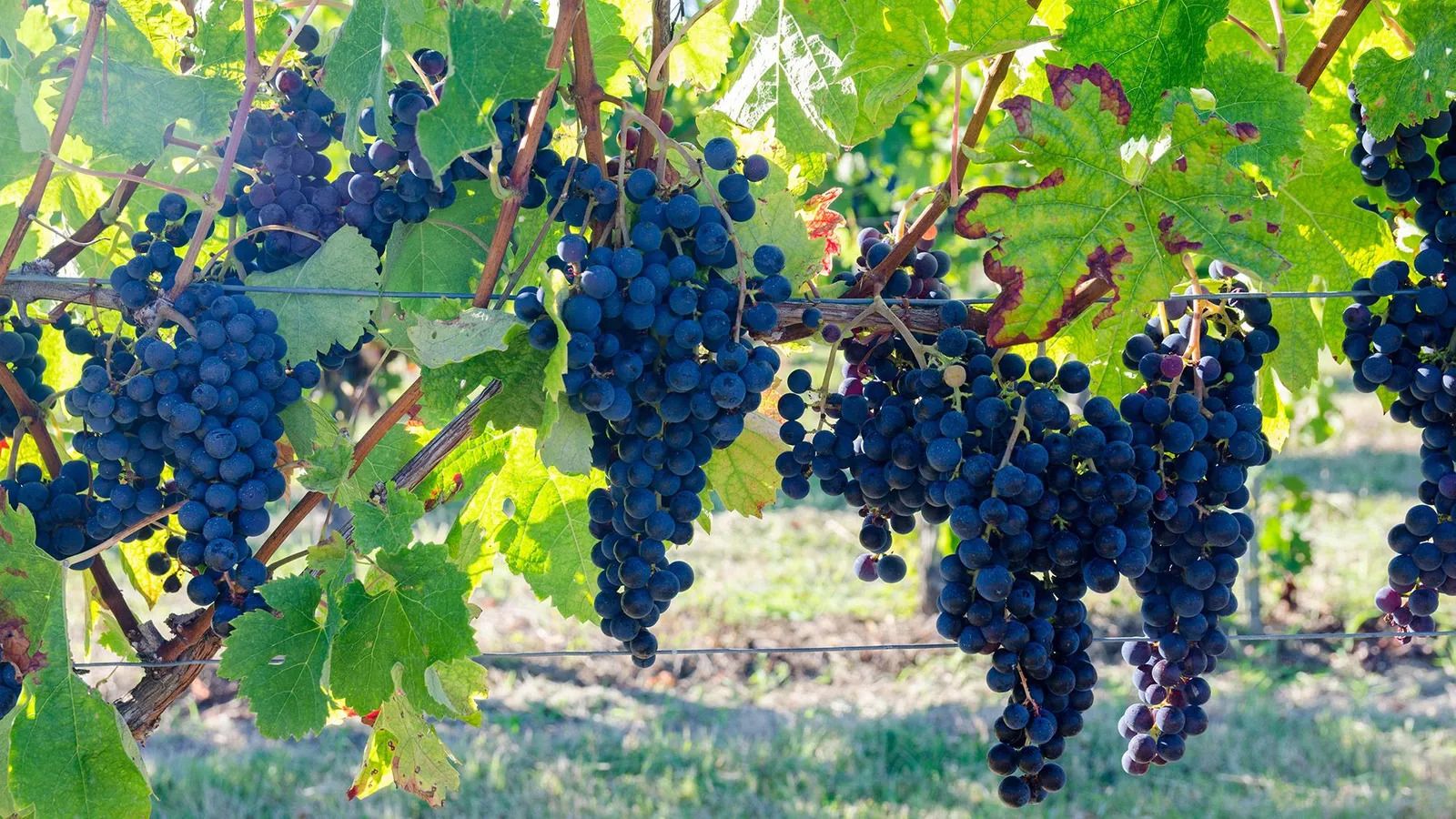 What makes a Bordeaux a Bordeaux? New grape varieties are being trialled
to maintain the characteristic Bordeaux flavour in a warmer climate
What makes a Bordeaux a Bordeaux? New grape varieties are being trialled
to maintain the characteristic Bordeaux flavour in a warmer climate
One sunny and warm day in November 2021, UC Davis viticulture researcher Kaan Kurtural leads us to a plot of vines at the Oakville Experimental Vineyard in Napa Valley, nestled between the forest-coated hills near other, commercial vineyards. Since 2016, Kurtural and colleagues have been monitoring 16 unique combinations of rootstocks and Cabernet Sauvignon clones to learn which combinations are most resilient under stressful conditions like heat waves and drought while still producing high-quality Cabernet Sauvignon grapes.
Some of the experimental grafts – including one with a French rootstock called 420A – clearly look wilted and, after just five years, some of them are dead. But others – including ones grafted onto the Austrian rootstock Kober 5 BB, the French 3309 Couderc and 110 Richter – look more vigorous and leafier.
Andy Beckstoffer, a prominent winegrower in Napa who is working with Kurtural on a similar trial at one of his own vineyards, tells us he thinks the results will be a boon to Cabernet Sauvignon in the coming years. "Hopefully, we will come up with new combinations that address climate change and also improve wine quality," he says.
Growers across the world already are changing traditional practices to temper the effects of a warming climate. Grapes are often harvested earlier in the year to prevent overripening and, in fire-prone regions, to miss the worst of wildfire season and avoid smoke taint. Bordeaux workers now rush to pick berries in the early morning when acidity is highest, and they trim bushy plants to curb sugar production.
At the Oakville research station, Kurtural shows us experiment after experiment investigating the effects of different viticultural practices, including a carbon-sucking grass that can grow between rows and vines tied up to wires in numerous trellising styles. Fortunately for places like drought-bedevilled California, the solution isn't simply more water; his research suggests that the most balanced and aromatic wines come from vines that are under constant, mild water stress. Tackling the Sun's radiation might be a better way forward.
"Some regions of the spectra can be damaging, such as near-infrared light," he'd explained earlier – they heat up the plant and the berries. At the vineyard, he leads us to a patch of Cabernet Sauvignon vines that have spent the past two seasons under parasol-like shade films. The films slow the ripening process and don't seem to affect how many berries the vines produce.
We get to taste the difference on the same trip, at a conference on wine research at UC Davis. There, Lauren Marigliano, one of Kurtural's graduate students, presents a chemistry analysis of grapes fully exposed to the Sun or protected by different types of shade. Afterward, she provides wine samples from three treatments for the audience of researchers, growers and winemakers to try.
Around us, professionals swirl their glasses, sniff, take sips and then spit into little plastic buckets. We watch their technique and gingerly follow suit. The first wine is quite bitter, and the second one tastes less complex – a nearby expert declares it unfortunately "square". We take a liking to the third one, which has a bolder berry aroma and a smoother taste. Attendees murmur approvingly at its "roundness".
That "round" one, it turns out, came from grapes grown under a shade film that blocked around 30% of near-infrared light, the wavelengths most responsible for heat transmission. By cooling the grapes, the film allowed them to accumulate higher concentrations of heat-sensitive anthocyanins than the grapes for the first and second samples. One of those was grown with a less effective shade film that blocked a different set of wavelengths, the other with no film at all. The winning film still let through enough light for Sun-dependent compounds to build up, creating a fuller-bodied, more complete red wine, Marigliano tells the audience.
But it's not always economical for farmers to erect long films along their rows of vines, especially over large acreages. That's where trellising comes in. During our tour of the experimental vineyard, Kurtural pauses at one point to gesture at a row of vines snaking along a single, high-hanging wire. This style of trellising works similarly to a good shade film by allowing the vine leaves themselves to shade the fruit, he explains.
Practices like shade films and grape-shielding trellising had mostly been limited to Australia, South America, Israel and Spain. "Now, with climate change, there's 30 years-ish of good research on warm climate viticulture that's all of a sudden relevant to places like Burgundy, Beaujolais, Germany, Napa and Sonoma," says Steve Matthiasson, a wine producer from Napa Valley who has adopted shade cloth. He's also planted his vines in a northeast-to-southwest orientation so that the sun shines directly on top of the vines, leaving the fruit protected by the leaves.
"Napa," he marvels, "was a cool climate growing region one generation ago."
Repairing climate impacts in wine
Even the toughest grapes can't always withstand extreme heat and smoke. So researchers and wine producers are also developing ways to work with climate-affected crops and still make well-rounded wines.
Oberholster reckons that many of the vines left unharvested after the massive 2020 California fires could still have produced good wine, so she encourages growers to do small-scale "bucket fermentations" a few weeks before harvest to test for smoke taint – since fermentation releases those ashtray-tasting phenols. Growers can then send a wine sample to a lab for analysis and taste the micro batches themselves – they might pick up changes that a commercial lab would miss, since the labs only screen for a limited menu of compounds and could pronounce a wine to be fine when it's not.
It can also help, adds Oberholster, to sweeten smokey wine with a little grape concentrate – that way, the extra sugar blocks enzymes in the mouth from releasing phenols. Even better would be removing the phenols altogether, but today's treatments, which include activated carbon and reverse osmosis, target a wide class of smokey compounds. So – inevitably – they also take away some desirable aromas. To that end, Oberholster is screening enzymes used in the food and beverage industries to find ones that might help to break down the undesired compounds in wine and render them easier to filter out.
Wine blending techniques can also help. Beckstoffer, for example, says that his 2020 smoke-tainted grapes were fermented and, when blended with untainted wines, "may not go into a $200 (£165) bottle of wine, but a lot of them could go into a $40 (£33) bottle of wine."
And Matthiasson carefully blends varieties to balance flavours: he picks Cabernet Sauvignon early in the season to preserve acidity, but that also means the grapes have less tongue-smothering richness, or mid-palate. So he mixes in Petit Verdot grapes to pump up the mid-palate and Cabernet Franc to fill in the gaps in herbal aromas.
He's also planted an emergency stash of the Sagrantino variety – "for 20 years down the road" – which is rich in the tannins that Cabernet Sauvignon grapes lose during warmer nights.
Warmer temperatures threaten Matthiasson's preferred style: wines lower in alcohol and higher in acidity than many of the full-bodied ones popular now. But he doesn't think that raisin-like wine everywhere is inevitable. In fact, some studies suggest that much of the rise in stronger, sweeter wines is a choice driven by vintners and consumer demand, not solely due to warming climates. "I get very frustrated by winemakers using climate change as an excuse for overripe, rich, jammy wine when it's not," he says.
Winemaking is also going high-tech to adapt to climate change. In France, microbiologist Fabienne Remize of the University of Montpellier has engineered novel strains of yeast that produce less alcohol during fermentation, to circumvent the too-much-sugar issue. Scientists have also developed an electrodialysis process that can dial up the acidity of wine by removing ions like potassium from it; the method has been adopted by winemakers in France, Morocco and Spain.
The future of wine
The biggest question for climate-changed wine and the adaptations that researchers and wine producers come up with is, of course: will people keep buying and enjoying it?
One of the more surprising lessons from consumer research is this embrace of bolder and jammier wines, as Kurtural and Gambetta have noted. In one study of red wines from Napa and Bordeaux, they found that wine ratings have actually risen over the last 60 years, even as those regions have warmed. The findings, they wrote, seem to quash a previous prediction that quality would peak at an average growing season temperature of 17.3C (63.1F) – which both regions have long since surpassed.
Still, Kurtural and Gambetta also note we might be reaching a tipping point where warmer temperatures wear away secondary compounds beyond the ability of growers to adapt. "Frankly, we don't know what the optimum is," Gambetta says. "We need better tools and better analysis to find out how far is too far."
Matthiasson, for his part, thinks that fine wines will weather the warming climate. With his shade cloths, blending techniques and emergency Sagrantino stash, he's ready for what comes next. "I think we're going to be able to adapt," he says. "In the short term, our pace of learning is faster than the pace of climate change."










